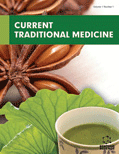[1]
Romanik G, Gilgenast E, Przyjazny A, Namiesnik J and , Kamiński M. Techniques of preparing plant material for chromatographic separation and analysis. J Biochem Biophys Methods 2007 Mar 10; 70(2): 253-61.
[2]
Van der Velde EG, de Haan W, Liem AKD. Supercritical fluid extraction of polychlorinated biphenyls and pesticides from soil. Comparison with other extraction methods. J Chromatogr A 1992; 626(1): 135-43.
[3]
Valle DL. Peptic Ulcer Diseases and Related Disorders. In: Braunwald E, Fauci AS, Kasper DL, Hauser SL, Longo DL, Jamson JL, Eds. Harrison’s Principles of Internal Medicine. 16th Ed. New York: Mc-Graw Hill Publications 2005; pp. 1746-62.
[4]
Grossman M. Peptic ulcer: A guide for practicing physicians Chicago Year Book Medical Publishers Am J Pharm Toxicol. 2009; 4: pp. (79)89-93.
[5]
Hoogerwerf WA, Pasricha PJ. Agents Used for Control of Gastric Acidity and Treatment of Peptic Ulcers and Gastro-Esophageal Reflux Disease. In: Hardman JG, Limbird LE, Goodman Gilman A, Eds. Goodman and Gilman The Pharmacological Basis of Therapeutics. 10th ed. NewYork: Mc-Graw Hill Publications 2001; pp. 1005-19.
[6]
Feldman M, Burton MEH. H2-receptor antagonists. Standard therapy for acid-peptic diseases. N Engl J Med 1990; 323: 1672-80.
[7]
Reilly JP. Safety profile of the proton-pump inhibitors. Am J Health Syst Pharm 1999; 56(23): S11-7.
[8]
Francho TG, Richter JE. Proton-pump inhibitors for gastric acid-related disease. Cleve Clin J Med 1998; 65: 27-34.
[9]
Chauhan DS, Merh SS. Evolutionary history of a lost river of Northwestern India Vedic Saraswati Banglore. Geological Society of India 1999; pp. 35-44.
[10]
Ravishankar B, Shukla VJ. Indian systems of medicine: a brief profile. Afr J Tradit CAM 2007; 4(3): 319-37.
[11]
Uma B, Prabhakar K, Rajendran S. In vitro antimicrobial activity and phytochemical analysis of Ficus religiosa L. and Ficus bengalensis L. against diarrhoeal enterotoxigenic E. coli. Ethnobot Leaflets 2009; 13: 472-4.
[12]
Ripu MK, Rainer WB. Ficus (Fig) species in Nepal: A review of diversity and indigenous uses. Lyonia 2006; 11(1): 85-97.
[13]
Sheetal A, Bagul MS, Prabia M, Rajani M. Evaluation of free radicals scavenging activity of an ayurvedic formulation P, panchvankala. Ind J Pharm Sci 2008; 70(1): 31-5.
[14]
Panchawat S, Sisodia SS. Comparative evaluation/optimization of soxhlet, ultrasication and microwave assisted extraction of Ficus religiosa Linn. Res J Pharmacogn Phytochem 2010; 2(4): 309-12.
[15]
Mukherjee PK. Quality Control of Herbal Drugs (An Approach to Evaluation of Botanicals). 1st Ed. New Delhi: Business Horizones Pharmaceutical Publishers 2000; pp. 246-370.
[16]
Indian Pharmacopoeia Vol. I, Delhi. Controller of Publications. 1996; pp. 134-5.
[17]
Garg GP, Nigam SK, Ogle CW. The gastric antiulcer effects of the leaves of the neem tree. Planta Med 1993; 59: 215-7.
[18]
Barros MPD, Lemos M, Maistro EL, et al. Evaluation of antiulcer activity of the main phenolic acids found in Brazilian Green Propolis. J Ethnopharmacol 2008; 120: 372-7.
[20]
Dharmani P, Kuchibhotla VK, Maurya R, Srivastava S, Sharma S, Palit G. Evaluation of anti-ulcerogenic and ulcer-healing properties of Ocimum sanctum Linn. J Ethanopharmacol 2004 Aug; 93(2-3): 197-206.
[21]
Robert A, Nezamis JE, Lancaster C, Hanchar AJ. Gastroenterol 1979; 77: 433.
[22]
Barocelli E, Chiavarini M, Ballabeni V, et al. Study of the antisecretory and antiulcer mechanism of new indenopyridazinone derivative in rats. Pharmacol Res 1997; 35: 487-92.
[23]
Kinoshita M, Tsunehisa N, Tamaki H. Effect of a combination of ecabet sodium and cimetidine on experimentally induced gastric lesions and gastric mucosal resistance to ulcerogenic agents in rats. Biol Pharm Bull 1995; 18: 223-6.
[24]
Oates PJ, Hakkinen JP. Studies on the mechanism of ethanol-induced gastric damage in rats. Gastroenterology 1988; 94: 10-21.
[25]
Szabo S. Mechanisms of mucosal injury in the stomach and duodenum: time-sequence analysis of morphologic, functional, biochemical and histochemical studies. Scand J Gastroenterol 1987; 127: 21-8.
[26]
Piper DW, Stiel DD. Pathogenesis of chronic peptic ulcer, current thinking and clinical implications. Med Pr 1986; 2: 7-10.
[27]
Surendra S. Evaluation of gastric antiulcer activity of fixed oil of tulsi and possible mechanism. Indian J Exp Biol 1999; 36: 253-7.
[28]
Guth PH, Paulsen G, Nagata H. Histologic and microcirculatory changes in alcohol-induced gastric lesions in the rat: effect of prostaglandin cytoprotection. Gastroenterology 1984; 87(5): 1083-90.
[29]
Parnham MJ, Brune K. Meeting report: Therapeutic control of inflammatory diseases. Agents Actions 1987; 21(3): 232-4.
[30]
Suzuki Y, Ishihara M, Segami T, Ito M. Anti-ulcer effects of antioxidants, quercetin, alpha-tocopherol, nifedipine and tetracycline in rats. Japan J Pharmacol 1998; 78: 435-41.
[31]
Xiao M, Yang Z, Jiu M, You J, Xiao R. The anti-gastroulcerative activity of beta-sitosterol-beta-D-glucoside and its aglycone in rats Hua xi yi ke da xue xue bao J West China Univ Med Sci Huaxi yike daxue xuebao 1992; 23(1): 98-101.
[32]
Pihan G, Regillo C, Szabo S. Free radicals and lipid peroxidation in ethanol- or aspirin-induced gastric mucosal injury. Dig Dis Sci 1987; 32(12): 1395-401.
[33]
Galati EM, Pergolizzi S, Miceli N, Monforte MT, Tripodo MM. Study on the increment of the production of gastric mucus in rats treated with Opuntia ficus indica (L.) Mill. Cladodes. J Ethanopharmacol 2002; 83: 229-33.
[34]
Borrelli F, Izzo AA. The plant kingdom as a source of anti-ulcer remedies. Phytother Res 2000; 14: 581-91.
[35]
Salvayre R, Braquet P, Perochot L, Douste-Blazy L. Comparison of the scavenger effect of bilberry anthocyanosides with various flavonoids. Flavonoids Bioflavonoids 1982; 11: 437-42.
[36]
Panchawat S, Sisodia SS. Comparison of free radical scavenging activity of Ficus religiosa Linn. stem bark extracts prepared by different methods of extraction. J Herbal Med Toxicol 2010; 4(2): 163-6.
[37]
Khan MSA, Hussain SA, Jais AMM, Zakaria ZA. Mohib Khan. Anti-ulcer activity of Ficus religiosa stem bark ethanolic extract in rats. J Med Plants Res 2011 Feb; 5(3): 354-9.





























